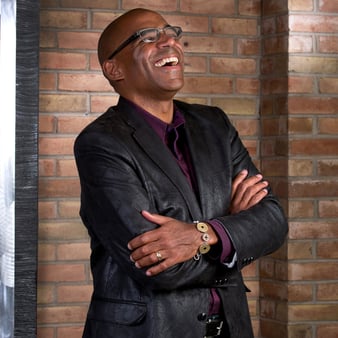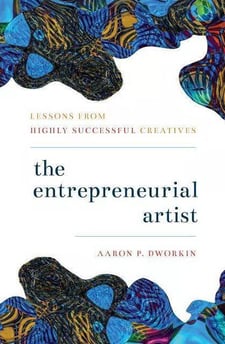This is a continuation of last week's blog post, Introducing The Entrepreneurial Artist, Part I, and includes excerpts from Aaron Dworkin's new book, The Entrepreneurial Artist: Lessons from Highly Successful Creatives, now available for pre-sale!
An Introduction of Uncommon Rhythm (cont.)
Artists are not taught to be businesspeople. Having served as dean at the University of Michigan’s School of Music, Theatre & Dance, among other opportunities, helped paved the way for me to enter the teaching realm. Now, as professor of arts leadership and entrepreneurship, through my Creative Entrepreneurship course, I guide my students through the world of entrepreneurship in the arts. I find, however, that many artists think entrepreneurship is a dirty word. They see it as either a diminishment of their artistic endeavors or something that is at best irrelevant. They don’t want to think about their art as a product to be valued but as a wholly unique thing that stands the test of time. To me, that seems misguided. Students in the arts are taught to think of their art as pure or sacred. As a result, they sometimes lack basic fundamental skills in making their art sustainable and sustaining. This lack of skills can translate into a fear of the unknown and—even worse—a fear of failure. That fear can lead to a paralysis.
Some of this comes more as a consequence of faulty assumptions, which in turn can form themselves due to outdated or in- complete perceptions of success and how it comes about. Art for art’s sake was never actually viable nor true. From Oscar Wilde to Frederick Chopin, art has been a vehicle for expressing views, narrating history, and ultimately for connecting with others on a human level. Wilde was a poet but also a playwright and a journalist: he found a plethora of avenues through which to profess his view on life. Chopin was not only a composer or a pianist. His “Revolutionary Etude” is not only a study for pianists: it is a musical narrative on the bombardment of his homeland. Artists are people who journey on a quest to find their mission and share it with others. Successful ones, one way or another, build an enterprise around it.

Success rarely emerges on its own. It is often the follow-up of failure, which is rarely easy but absolutely essential. I’ve dealt with plenty of it. Before I started Sphinx, I had a handful of nonprofits, literary magazines, and other organizations that just never got off the ground. But if you are afraid of trying and failing, you’ll never succeed. Resilience in the face of failure is what the hustle is all about.
Here is where artists have the upper hand over traditional entrepreneurs—artists thrive on failure. They take criticism every day in their rehearsal halls, studios, and work spaces. And when they fail, they learn to do it better for the next concert or gallery show. Good artists are experts at taking criticism and growing from experience. In fact, as artists, we do not define failure as such, but rather interpret it as an inseparable part of the process.
We’re accustomed to associating the word entrepreneur with successful names like Zuckerberg, Musk, and Bezos. We think about entrepreneurship as something locked up in the Bay area, a thing that only “tech bros” would understand. Tech bros, how- ever, do not hold a monopoly on entrepreneurship. As a matter of fact, some of the best entrepreneurs are artists—some of whom you know and admire.
These successful artists exhibit the same behavior as the tech giants featured in Wired or Gizmodo. Their tenacity, drive, and conviction have raised them to the highest levels of our cultural consciousness. For me, capitalizing on that fascination has been pivotally important. I tell my students to tap into that fascination, question and understand how exactly these guys got there. What was their secret recipe? What was the key to their success? How did they get to where they are? Is there a formula for this success? In many ways, this book tells stories as divergent as a spider web, but the common threads you will find woven among them illuminate a path that connects the creativity in all of us. Their stories are our stories. Their questions are our questions. Their dreams are similar to yours and mine. But what truly separates dreamers from doers? And is there a difference between doers and legends?
In order to find out, I identified thirteen individuals who I think exemplify the term creative entrepreneur. I listened to these individuals’ stories and studied how they succeeded in the face of adversity. What I learned I’ve shared here with you in this book. These are heroes of mine—and hopefully yours soon as well. Some things you might read may be very much as you might expect. Many details may surprise you, and I truly hope they do. My wish for you is that you find enough that will resonate but even more that may awaken something new inside you. A new wave of inspiration. A desire to challenge yourself, the courage to keep searching. A different way to see yourself as an architect of your life’s mission, an engineer of your own sense of purpose.
From every genre, discipline, and walk of life, these thirteen artists have surpassed others in their field. They know the hardship of the hustle but also the warm glow of greatness. In speaking with these luminaries, I learned that they are exceptional at three specific things:
- ideation,
- organization, and
- communication
To the thirteen artists in this book, progress isn’t fueled just by inspiration. It’s work—and hard work at that. It’s work structured to enable them to achieve a goal: doing more of what they love and being unafraid to continually reinvent themselves to stay relevant. Artists are constantly struggling with inspiration. Where do you get it? How do you get it? When inspiration strikes, the artist often turns it into a piece of work in their medium. But how can they be inspired to create without limit? Creative entrepreneurs know that inspiration is only a single part of their job. Creative entrepreneurs produce ideation—that is, they’re idea machines, articulating their ideas in a way others can understand. Every day they come up with new ideas because they know that if they don’t, someone else will come up with that idea instead. The creative entrepreneur seeks inspiration from everything, and they have a structure to get inspired.
 They also know that creativity thrives on constraint and truly flourishes with organization. They know the ideas that come pouring out of them are not all good ideas. Their best ideas are simple and concise. They can take these best ideas and turn them into actionable plans. When they focus on a plan, they bring to it the same fervor they bring to practicing their craft. Everything that surrounds them reminds them of their art and passion, down to the exact specifications and decorations of their workspaces. For them, a portfolio isn’t just a collection of their work. They live and breathe their portfolio lives, curating different ventures and expanding their knowledge daily.
They also know that creativity thrives on constraint and truly flourishes with organization. They know the ideas that come pouring out of them are not all good ideas. Their best ideas are simple and concise. They can take these best ideas and turn them into actionable plans. When they focus on a plan, they bring to it the same fervor they bring to practicing their craft. Everything that surrounds them reminds them of their art and passion, down to the exact specifications and decorations of their workspaces. For them, a portfolio isn’t just a collection of their work. They live and breathe their portfolio lives, curating different ventures and expanding their knowledge daily.
And they are convincing. Creative entrepreneurs know they can’t do it alone. Communication is their best tool to make their ventures a success. They can fit their communication style to their audience—conveying both their organizational goals and their artistic passions in a conversation, e-mail, or grant proposal. While most artists struggle to communicate the point of their work, creative entrepreneurs can convey their ideas succinctly and inspiringly.
These skillsets are not the only necessity. you still need talent and resilience—the mainstays of every artist’s personality—and luck. As an artist, you might not necessarily want to be your own manager, but you need to know how to manage. Creative entrepreneurs have goals. The frameworks they build around themselves through ideation, organization, and communication not only make them better artists but create new opportunities for them to make art again and again. This process moves their art forward. An entrepreneur has no time to be paralyzed by artistic doubt.
No matter what the discipline, the arts field is competitive. No one goes into the arts because they think it’ll be easy. Whether they’re auditioning for a spot in an orchestra or writing pitches to donors, they do what they do because they love it. The jobs these artists seek are incredibly competitive—often with hundreds or thousands of applicants for only a handful of positions. you can practice hard, do your research on an organization, present yourself well at an interview or audition, and still not get the gig.
With the lessons you’ll learn from these thirteen individuals, however, you’ll have a distinct advantage over other artists who don’t know the value of an entrepreneurial spirit. you’ll have more ideas about where to take your art. you’ll be able to put yourself in situations that position you for success. And you’ll be able to convince the people you need to win over when you get there.
There’s an age-old joke: “How do you get to Carnegie Hall?” The answer, of course, is practice, practice, practice. I’m glad I practiced. Not only did I eventually get to Carnegie Hall, I was able to bring dozens of deserving artists I care about to perform there. I got there through a combination of grit, creativity, and luck, practicing my proverbial instrument through entrepreneurship, each and every day, without fail. With your own talent, skills, and determination, you can get where you are seeking to go.
Read more articles from our Black History Month series.
Read more articles from our The Lives of Artists . . . In Their Own Words series.


